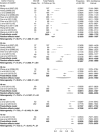Emerging trends of HIV drug resistance in Chinese HIV-infected patients receiving first-line highly active antiretroviral therapy: a systematic review and meta-analysis
- PMID: 25053721
- PMCID: PMC4565655
- DOI: 10.1093/cid/ciu590
Emerging trends of HIV drug resistance in Chinese HIV-infected patients receiving first-line highly active antiretroviral therapy: a systematic review and meta-analysis
Abstract
Background: Highly active antiretroviral therapy (HAART) has led to a dramatic decrease in AIDS-related morbidity and mortality through sustained suppression of human immunodeficiency virus (HIV) replication and reconstitution of the immune response. Settings like China that experienced rapid HAART rollout and relatively limited drug selection face considerable challenges in controlling HIV drug resistance (DR).
Methods: We conducted a systematic review and meta-analysis to describe trends in emergent HIV DR to first-line HAART among Chinese HIV-infected patients, as reflected in the point prevalence of HIV DR at key points and fixed intervals after treatment initiation, using data from cohort studies and cross-sectional studies respectively.
Results: Pooled prevalence of HIV DR from longitudinal cohorts studies was 10.79% (95% confidence interval [CI], 5.85%-19.07%) after 12 months of HAART and 80.58% (95% CI, 76.6%-84.02%) after 72 months of HAART. The HIV DR prevalence from cross-sectional studies was measured in treatment intervals; during the 0-12-month HAART treatment interval, the pooled prevalence of HIV DR was 11.1% (95% CI, 7.49%-16.14%), which increased to 22.92% at 61-72 months (95% CI, 9.45%-45.86%). Stratified analyses showed that patients receiving a didanosine-based regimen had higher HIV DR prevalence than those not taking didanosine (15.82% vs 4.97%). Patients infected through former plasma donation and those receiving AIDS treatment at village clinics had higher HIV DR prevalence than those infected through sexual transmission or treated at a county-level hospital.
Conclusions: Our findings indicate higher prevalence of HIV DR for patients with longer cumulative HAART exposure, highlighting important subgroups for future HIV DR surveillance and control.
Keywords: HIV/AIDS; drug resistance; highly active antiretroviral therapy; meta-analysis.
© The Author 2014. Published by Oxford University Press on behalf of the Infectious Diseases Society of America. All rights reserved. For Permissions, please e-mail: journals.permissions@oup.com.
Figures



References
-
- Palella FJ, Jr, Delaney KM, Moorman AC, et al. Declining morbidity and mortality among patients with advanced human immunodeficiency virus infection. HIV Outpatient Study Investigators. N Engl J Med. 1998;338:853–60. - PubMed
-
- DeGruttola V, Dix L, D'Aquila R, et al. The relation between baseline HIV drug resistance and response to antiretroviral therapy: re-analysis of retrospective and prospective studies using a standardized data analysis plan. Antivir Ther. 2000;5:41–8. - PubMed
Publication types
MeSH terms
Substances
Grants and funding
LinkOut - more resources
Full Text Sources
Other Literature Sources
Medical
Molecular Biology Databases

